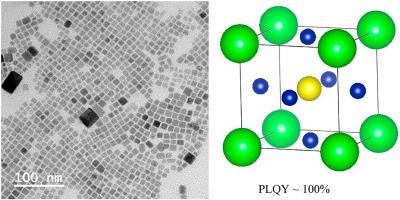Journal of Luminescence ( IF 3.3 ) Pub Date : 2021-07-19 , DOI: 10.1016/j.jlumin.2021.118345 Srinivasa Rao Pathipati 1

|
In this work, luminescent perovskite nanocrystals (PNCs) were grown by the modified hot-injection method under reduced pressure at low temperatures. This modified method utilizing the property of reduction of the boiling point of the solvent under reduced pressure. This proposed method facilitates the growth of high-quality nanocrystals (NCs) without a Schlenk line and inert environment. The synthesis temperature of these PNCs using this method is reduced by 30–40 °C compared to the conventional hot-injection method. Different PNCs starting from nanoplatelets to nanocubes and nanorods were successfully grown using this method. The morphology, structural and luminescence properties of the NCs which are grown by this modified hot-injection method depend on synthesis temperature. The average lifetime of the charge carriers in PNCs is estimated from the time-resolved photoluminescence (TRPL) measurements is of the order of 25–75ns. The nanocubes synthesized at 120 °C reaches nearly 100% photoluminescence quantum yield (PLQY) within the measurement error and also exhibit excellent stability. The aged nanocrystals synthesized at 120 °C retain 83% of their initial PLQY when exposed to an ambient atmosphere for one month. Besides, we have investigated the origin of the instability of these PNCs when exposed to an ambient atmosphere. It is evident from the X-ray diffraction (XRD) measurements the degradation of the PNCs via the formation of the Cs-rich by-product Cs4PbBr6. The main reason for the formation of the Cs-rich by-product is due to the limited solubility of PbBr2 at relatively low temperatures, which results in the vacancy formation of Pb and Br during synthesis. Another reason for the formation of Cs-rich by-product Cs4PbBr6 nanospheres is due to the ligand loss from the surface of the PNC which might cause the Pb and Br defects.
中文翻译:

钙钛矿纳米晶体的真空辅助低温生长达到接近统一的光致发光量子产率
在这项工作中,发光钙钛矿纳米晶体(PNCs)是通过改进的热注射法在低温减压下生长的。这种改进的方法利用了在减压下降低溶剂沸点的特性。这种提议的方法促进了高质量纳米晶体 (NC) 的生长,而无需 Schlenk 线和惰性环境。与传统的热注射方法相比,使用这种方法的这些 PNC 的合成温度降低了 30-40°C。使用这种方法成功地生长了从纳米片到纳米立方体和纳米棒的不同 PNC。通过这种改进的热注射方法生长的 NCs 的形态、结构和发光特性取决于合成温度。PNC 中电荷载流子的平均寿命是根据时间分辨光致发光 (TRPL) 测量估计的,大约为 25-75ns。在 120 °C 合成的纳米立方体在测量误差范围内达到近 100% 的光致发光量子产率 (PLQY),并且还表现出优异的稳定性。在 120°C 下合成的老化纳米晶体在暴露于环境大气 1 个月时保留其初始 PLQY 的 83%。此外,我们还研究了这些 PNC 在暴露于环境大气中时不稳定的原因。从 X 射线衍射 (XRD) 测量结果可以明显看出,通过形成富含 Cs 的副产物 Cs,PNCs 的降解 在 120 °C 合成的纳米立方体在测量误差范围内达到近 100% 的光致发光量子产率 (PLQY),并且还表现出优异的稳定性。在 120°C 下合成的老化纳米晶体在暴露于环境大气 1 个月时保留其初始 PLQY 的 83%。此外,我们还研究了这些 PNC 在暴露于环境大气中时不稳定的原因。从 X 射线衍射 (XRD) 测量结果可以明显看出,通过形成富含 Cs 的副产物 Cs,PNCs 的降解 在 120 °C 合成的纳米立方体在测量误差范围内达到近 100% 的光致发光量子产率 (PLQY),并且还表现出优异的稳定性。在 120°C 下合成的老化纳米晶体在暴露于环境大气 1 个月时保留其初始 PLQY 的 83%。此外,我们还研究了这些 PNC 在暴露于环境大气中时不稳定的原因。从 X 射线衍射 (XRD) 测量结果可以明显看出,通过形成富含 Cs 的副产物 Cs,PNCs 的降解4 PbBr 6。形成富含 Cs 的副产物的主要原因是由于 PbBr 2在相对较低的温度下的溶解度有限,这导致合成过程中 Pb 和 Br 的空位形成。形成富含 Cs 的副产物 Cs 4 PbBr 6纳米球的另一个原因是 PNC 表面的配体损失,这可能导致 Pb 和 Br 缺陷。











































 京公网安备 11010802027423号
京公网安备 11010802027423号